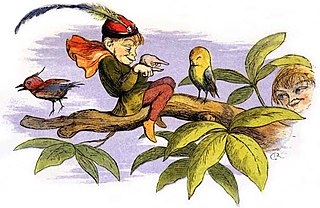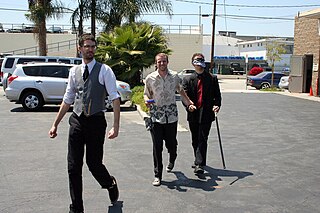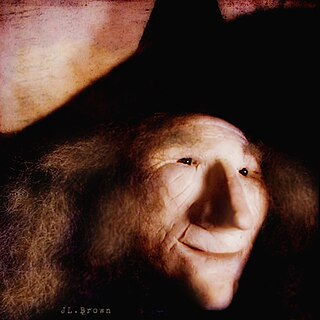
In Gaelic mythology the Cailleach is a divine hag, a creator deity, a weather deity, and an ancestor deity. She is also commonly known as the Cailleach Bhéara(ch) or Bheur(ach). In Scotland she is also known as Beira, Queen of Winter. The word literally means "old woman, hag", and is found with this meaning in modern Irish and Scottish Gaelic, and has been applied to numerous mythological figures in Ireland, Scotland and the Isle of Man.
In Welsh mythology and folklore, Cŵn Annwn were the spectral hounds of Annwn, the otherworld of Welsh myth. They were associated with a form of the Wild Hunt, presided over by either Arawn, king of Annwn in the First Branch of the Mabinogi and alluded to in the Fourth, or by Gwyn ap Nudd as the underworld king and king of the fair(y) folk is named in later medieval lore.
In Irish, a geas is an idiosyncratic taboo, whether of obligation or prohibition, similar to being under a vow. The plural geasa is also used to mean specifically a spell prohibiting some action, common in Irish folklore and mythology. It is this additional meaning of the plural which the article discusses.

The Bogeyman is a mythical creature used by adults to frighten children into good behaviour. The Bogeyman has no specific appearance, and conceptions vary drastically by household and culture, but is commonly depicted as a masculine or androgynous monster that punishes children for misbehavior. Bogeymen may target a specific act or general misbehaviour, depending on what purpose needs serving, often based on a warning from the child's authority figure.

English folklore is the folk tradition which has developed in England over a number of centuries. Some stories can be traced back to their roots, while the origin of others is uncertain or disputed. England abounds with folklore, in all forms, from such obvious manifestations as the traditional Robin Hood tales, the Brythonic-inspired Arthurian legend, to contemporary urban legends and facets of cryptozoology such as the Beast of Bodmin Moor.

A bachelor party, also known as a stag party, stag night, stag do, stag weekend, or a buck's night is a party held for the man who is to shortly enter marriage.
Gwyllion or gwyllon is a Welsh word with a wide range of possible meanings including "ghosts, spirits" and "night-wanderers up to no good, outlaws of the wild." Gwyllion is only one of a number of words with these or similar meanings in Welsh. It is a comparatively recent word coined inadvertently in the seventeenth century by the Welsh lexicographer Dr John Davies (Mallwyd).
In the Dungeons & Dragons role-playing game, Cegilune is the hag deity of larvae, hags, and the moon. She is the patron goddess of all hags, including night hags. Her symbol is an overflowing black cauldron.
Brazilian mythology is the subset of Brazilian folklore with cultural elements of diverse origin found in Brazil, comprising folk tales, traditions, characters and beliefs regarding places, peoples, and entities. The category was originally restricted to indigenous elements, but has been extended to include:

In the Dungeons & Dragons fantasy role-playing game, hags are female, witchlike creatures known for their cruelty and repulsiveness. They use their magic to sow discord and to spread corruption. Many hag variations have appeared in the numerous editions of Dungeons & Dragons since their first appearance in a 1975 rules supplement.
"The Marriage of Sir Gawain" is an English Arthurian ballad, collected as Child Ballad 31. Found in the Percy Folio, it is a fragmented account of the story of Sir Gawain and the loathly lady, which has been preserved in fuller form in the medieval poem The Wedding of Sir Gawain and Dame Ragnelle. The loathly lady episode itself dates at least back to Geoffrey Chaucer's "Wife of Bath's Tale" from The Canterbury Tales. Unlike most of the Child Ballads, but like the Arthurian "King Arthur and King Cornwall" and "The Boy and the Mantle", "The Marriage of Sir Gawain" is not a folk ballad but a song for professional minstrels.
The cyhyraeth, also spelled cyoeraeth or cyheuraeth, is a ghostly spirit in Welsh mythology, a disembodied moaning voice that sounds before a person's death.
A hag is a wizened old woman, or a fairy with the appearance of an old woman.

Slieve na Calliagh is a range of hills and archaeological site near Oldcastle, County Meath, Ireland. The hills rise to 276 metres (906 ft) above sea level, the highest point in the county. On the hilltops are a group of megalithic tombs dating back to the 4th millennium BC. These tombs are also known as Slieve na Calliagh, or as the Loughcrew tombs. The rays of the equinox sunrise shine down the passageway of the Cairn T and illuminate an inner chamber filled with megalithic stonecarvings. It is deemed one of the four main passage tomb sites in Ireland and is a protected National Monument.

Donald Jacob "Jake" Hager Jr. is an American professional wrestler and mixed martial artist, best known for his time in WWE under the ring name Jack Swagger. He is currently signed to Lucha Underground under the ring name Jake Strong, where he is the current Lucha Underground Champion. He is also signed as a heavyweight to the Bellator MMA promotion.

A hag is a wizened old woman, or a kind of fairy or goddess having the appearance of such a woman, often found in folklore and children's tales such as Hansel and Gretel. Hags are often seen as malevolent, but may also be one of the chosen forms of shapeshifting deities, such as the Morrígan or Badb, who are seen as neither wholly beneficent nor malevolent.
Nicneven or Nicnevin or Nicnevan is a Queen of the Fairies in Scottish folklore. In Ireland and Scotland, "the Feile na Marbh", took place on Samhain The names Satia, NICNEVEN, Bensozie, Zobiana, Abundia, Herodiana, were all used to identify the Scottish Witch Goddess of Samhain. The use of the name for this meaning was first found in Montgomerie’s Flyting (c.1585) and was seemingly taken from a woman in Scotland condemned to death for witchcraft before being burnt at the stake as a witch. In the Borders the name for this archetype was Gyre-Carling whose name had variants such as Gyre-Carlin, Gy-Carling, Gay-Carlin amongst others. Gyre is possibly a cognate of the Norse word geri and thus having the meaning of "greedy" or it may be from the Norse gýgr meaning "ogress"; carling or carline is a Scots and Northern English word meaning "old woman" which is from, or related to, the Norse word kerling.









